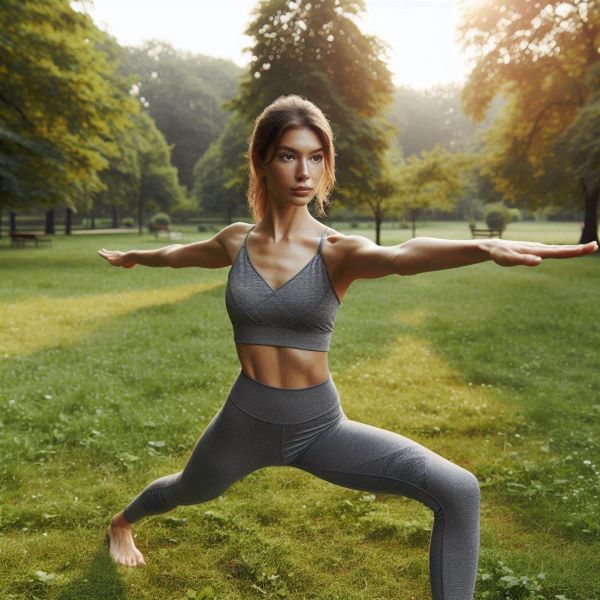Virabhadrasana II, known in English as the Warrior Pose II, is a powerful standing yoga posture that embodies strength, stability, and focus. The name is derived from the Sanskrit words “Virabhadra” (a fierce warrior) and “Asana” (pose). There are three primary variations of this pose: Warrior I (Virabhadrasana I), Warrior II (Virabhadrasana II), and Warrior III (Virabhadrasana III). Each variation offers unique benefits and challenges to the practitioner.
History
Virabhadrasana is rooted in Hindu mythology, named after the warrior Virabhadra, an incarnation of Lord Shiva. According to legend, Virabhadra was created by Shiva to avenge the death of his beloved wife, Sati. The pose symbolizes the courage and strength of a warrior, making it a powerful addition to any yoga practice. This pose has been practiced for centuries and is a staple in many yoga traditions, particularly Hatha Yoga.
How to Do Virabhadrasana II
Below are the steps for each variation of Virabhadrasana:
Virabhadrasana I (Warrior I)
- Starting Position: Begin in Tadasana (Mountain Pose). Step your feet about 3-4 feet apart.
- Positioning the Feet: Turn your right foot out 90 degrees and your left foot slightly inward (about 45 degrees). Align the heels of both feet.
- Bending the Knee: Bend your right knee so that it is directly over your right ankle, forming a 90-degree angle.
- Raising the Arms: Inhale and raise your arms overhead, bringing your palms together or keeping them shoulder-width apart. Stretch through your fingertips.
- Aligning the Hips: Square your hips toward the front. Ensure your left leg is straight and your back heel is pressing into the ground.
- Holding the Pose: Hold the pose for 5-10 breaths, maintaining a steady and deep breathing pattern.
- Releasing the Pose: Exhale and lower your arms. Straighten your right leg and repeat on the opposite side.
Virabhadrasana II (Warrior II)
- Starting Position: Begin in Tadasana. Step your feet wide apart, about 4-5 feet.
- Positioning the Feet: Turn your right foot out 90 degrees and your left foot slightly inward. Align your right heel with the arch of your left foot.
- Bending the Knee: Bend your right knee so that it is directly over your right ankle, forming a 90-degree angle. Ensure your left leg is straight.
- Extending the Arms: Inhale and extend your arms parallel to the floor, palms facing down. Keep your shoulders relaxed.
- Gazing Forward: Turn your head to look over your right hand. Maintain a strong and steady gaze.
- Holding the Pose: Hold the pose for 5-10 breaths, focusing on stability and strength.
- Releasing the Pose: Straighten your right leg, lower your arms, and repeat on the opposite side.
Virabhadrasana III (Warrior III)
- Starting Position: Begin in Tadasana. Shift your weight onto your right foot.
- Raising the Back Leg: Inhale and lift your left leg behind you, keeping it straight. Simultaneously, extend your arms forward.
- Balancing: Keep your body parallel to the ground, forming a straight line from your fingertips to your lifted heel. Engage your core for stability.
- Aligning the Hips: Ensure your hips are square to the ground. Avoid opening your left hip.
- Holding the Pose: Hold the pose for 5-10 breaths, maintaining balance and focus.
- Releasing the Pose: Lower your left leg, return to Tadasana, and repeat on the opposite side.
Health Benefits
Practicing Virabhadrasana regularly offers several health benefits, including:
- Strengthening Muscles: Tones the legs, arms, shoulders, and core.
- Improving Balance: Enhances stability and coordination.
- Increasing Endurance: Builds stamina and endurance in the legs and arms.
- Enhancing Flexibility: Stretches the chest, shoulders, neck, and thighs.
- Boosting Concentration: Promotes mental focus and clarity.
Also, read: Quickly Learn all about Trikonasana- Triangle Posture
Who Should Do Virabhadrasana II
Virabhadrasana is beneficial for most individuals, especially those who:
- Want to improve their overall strength and balance.
- Seek to enhance their flexibility and endurance.
- Are looking to build mental focus and concentration.
- Experience mild back or hip discomfort.
Who Should Not Do Virabhadrasana II
Certain individuals should take precautions or avoid practicing Virabhadrasana:
- Those with severe knee, hip, or ankle injuries.
- Individuals with chronic shoulder issues.
- People with high blood pressure should avoid raising their arms overhead for extended periods (for Warrior I).
- Pregnant women should practice under the guidance of a yoga instructor to ensure proper modifications.
Precautions to Take
When practicing Virabhadrasana, keep these precautions in mind:
- Avoid locking your knees; keep a micro-bend to prevent strain.
- Ensure your front knee is aligned with your ankle to avoid injury.
- Engage your core muscles to support your spine and maintain balance.
- If you experience dizziness or discomfort, come out of the pose and rest.
References and Sources
By incorporating Virabhadrasana into your regular yoga practice, you can enjoy its numerous benefits while cultivating strength, balance, and mental focus. Always practice mindfully and consult with a yoga instructor if you have any health concerns.





